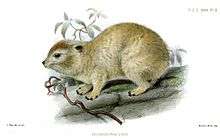Western tree hyrax
| Western tree hyrax[1] | |
|---|---|
| | |
| Scientific classification | |
| Kingdom: | Animalia |
| Phylum: | Chordata |
| Class: | Mammalia |
| Order: | Hyracoidea |
| Family: | Procaviidae |
| Genus: | Dendrohyrax |
| Species: | D. dorsalis |
| Binomial name | |
| Dendrohyrax dorsalis (Fraser, 1853) | |
 | |
| Western tree hyrax range | |
The western tree hyrax (Dendrohyrax dorsalis), also called the western tree dassie or Beecroft's tree hyrax, is a species of tree hyrax within the family Procaviidae. It can be distinguished from other hyraxes by short coarse fur, presence of white patch of fur beneath the chin, lack of hair on the rostrum, and lower crowns of the cheek teeth compared to other members of the same genus. [3]
Behavior
Western tree hyraxes tend to be solitary, and only occasionally are found in groups of two or three. They are nocturnal and generally feed at night. It has been noted that this species is an especially adept climber. In captivity they have been observed to climb up the edge of an open door with ease, as well as being able to quickly scale smooth tree trunks. They are aided in climbing with their black, pliant footpads with numerous ridges. Captive animals were observed using their teeth to help hold on to wires and vines while climbing.[4] Anticipatory to copulation the female produces a secretion from the dorsal gland that smells similar to cinnamon.
Ecology
Common predators of the western tree hyrax are eagles, leopards, hawks, servals, pythons, and golden cats, in addition to occasionally being hunted by humans for food. In Bossou, Guinea, one notable ecological association with chimpanzees occurs. A chimpanzee at Bossou was observed capturing a western tree hyrax, carrying it to her nest, and sleeping with and grooming it. This suggests that chimpanzees in Bossou may not regard hyraxes as a prey animal.[5]
Range and habitat

The western tree hyrax is found in West and Central Africa: Benin, Cameroon, Central African Republic, Republic of the Congo, Democratic Republic of the Congo, Ivory Coast, Equatorial Guinea, Gabon, Gambia, Ghana, Guinea, Guinea-Bissau, Liberia, Nigeria, Rwanda, Senegal, Sierra Leone, South Sudan, Togo, Uganda, and possibly Niger. Its natural habitats are subtropical or tropical moist lowland forests, moist savanna, and rocky areas.[2]
References
- ↑ Shoshani, J. (2005). Wilson, D.E.; Reeder, D.M., eds. Mammal Species of the World: A Taxonomic and Geographic Reference (3rd ed.). Johns Hopkins University Press. pp. 87–88. ISBN 978-0-8018-8221-0. OCLC 62265494.
- 1 2 Barry, R., Bloomer, P., Hoeck, H. & Shoshani, H. (2008). Dendrohyrax dorsalis. In: IUCN 2008. IUCN Red List of Threatened Species. Retrieved 29 December 2008.
- ↑ Kowalski, K. (1976). Mammals, and outline of theriology. Panstwowe Wydawnicto Naukowe, Warszawa. English Edition. pp. 617
- ↑ Jones, Clyde. (1978) Dendrohyrax Dorsalis. Mammalian Species, No 113,. pp. 1-4
- ↑ Hirata S, Yamakoshi G, Fujita S, Ohashi G, Matsuzawa T (2001) Capturing and Toying with Hyraxes (Dendrohyrax dorsalis) by Wild Chimpanzees (Pan troglodytes) at Bossou, Guinea American Journal of Primatology 53, 93-97
| ||||||||||||||||||||||||
